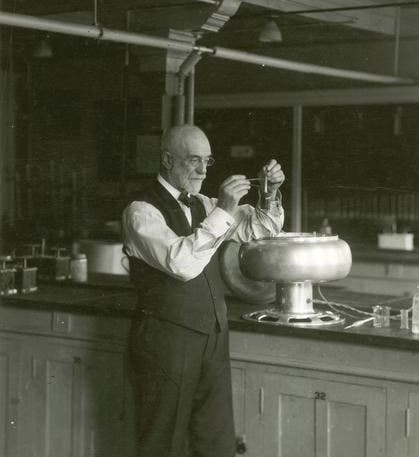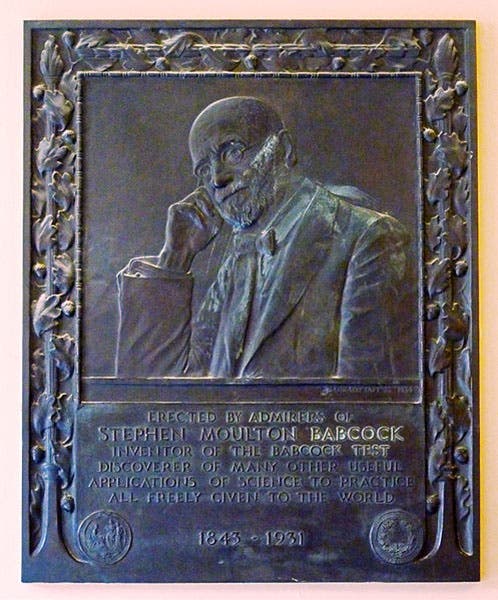Scientist of the Day - Stephen Moulton Babcock
Stephen Moulton Babcock, an American agricultural chemist and food scientist, was born Oct. 22, 1843. Babcock spent much of his career at the University of Wisconsin (UW) and its Agricultural Experiment Station, and he is somewhat of a Paul Bunyan-like hero in the Dairy State, because of the contributions he made to dairy farming and the production of cheese, as well as cattle raising. In 1890, he devised a very simple test for measuring the butterfat content of milk. One first liberated the fat globules in a sample of milk by dissolving the casein in a strong acid, and then separated the fat by means of a centrifuge. The butterfat content could be read directly from a scale on the centrifuged tube. The Babcock test, as it was soon called, discouraged milk adulteration and provided for the first time an adequate standard by which fair payment for milk could be determined. It also stimulated improvement of dairy production and aided in factory manufacture of cheese and butter. Babcock’s paper, like most of his work, was published in a Bulletin of the UW Experiment Station, and while we have many of the Bulletins and Research Bulletins of the Station, we do not have this one.
Babcock (with a colleague, H.L. Russell) also discovered that cheese could be cured at cold temperatures. Conventional old-world cheese wisdom held that proper cheese curing could only be done at room temperatures, which required great vigilance to prevent the introduction of unwanted molds and fermenting agents. In an elaborate series of tests, Babcock and Russell discovered that cheese cured at 35 degrees is indistinguishable from cheese cured at 65 degrees, and far less likely to be contaminated by foreign bacteria. He published a long paper (in fact, it took up an entire issue) in the Bulletin of the Bureau of Animal Industry of the USDA in 1903, and this Bulletin we do have (second image). Cold-curing would revolutionize the cheese industry in Wisconsin, and probably contributed to its other nickname, the Cheese State.
For much of his career at Wisconsin, Babcock wanted to carry out nutritional experiments on cows, to see if one grain were better than another, but he was prevented from conducting these experiments by various administrators for almost 25 years, for reasons not explained. Finally, in 1906, Babcock encouraged others to conduct his experiments, by which it was discovered that cows fed on corn fared better than those raised on wheat or oats, even though the diets were chemically equivalent. The Dairy Barn (fourth image) where the “single-grain” experiments were conducted from 1907 to 1911 was recently named a National Historic Landmark, primarily because it housed these experiments. The results were published in 1911, and not only marked the beginning of nutrition science, but suggested that there were unknown factors contributing to successful diets that could not yet be explained. The discovery of "accessory food factors" or vitamins by F. Gowland Hopkins in 1912 would provide that explanation.
A prominent feature of the west end of the UW-Madison campus is Babcock Hall, built in 1951 to house the Department of Food Science (and not too far from the Dairy Barn). Everyone on campus knows about Babcock Hall because that is where you go to get homemade ice-cream from UW's contented corn-fed cows. It was so in my day, and although they have greatly expanded Babcock Hall since then, it looks as if it is still true today (fifth image).
Dr. William B. Ashworth, Jr., Consultant for the History of Science, Linda Hall Library and Associate Professor, Department of History, University of Missouri-Kansas City. Comments or corrections are welcome; please direct to ashworthw@umkc.edu.







![“Aurora Borealis,” hand-colored wood engraving by Josiah Wood Whymper, [Natural Phenomena], plate 2, 1846 (Linda Hall Library)](https://assets-us-01.kc-usercontent.com:443/9dd25524-761a-000d-d79f-86a5086d4774/0245ffcb-b70c-477c-8792-0a73ebd54eb2/Whymper%2011.jpg?w=210&h=210&auto=format&fit=crop)


